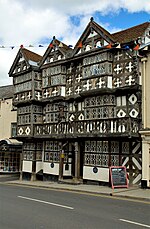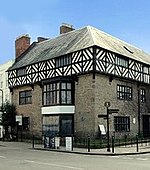The Bull Hotel, Ludlow
Buildings and structures in LudlowGrade II listed hotelsGrade II listed pubs in ShropshireHotels in ShropshireUnited Kingdom hotel stubs

The Bull Hotel is a historic inn in Ludlow, at 14 Bull Ring. The public house is described as "the best surviving medieval inn in Ludlow" and pre-dates the Feathers Hotel opposite. It is a Grade II listed building. Much of the current three-storey building dates to the 16th century, but the painted stucco front date from the 18th century and the roof tiles from the 20th century.During the Ludlow Festival in the summer, the hotel hosts the Fringe Festival, featuring live jazz music and plays in the courtyard of the hotel.
Excerpt from the Wikipedia article The Bull Hotel, Ludlow (License: CC BY-SA 3.0, Authors, Images).The Bull Hotel, Ludlow
Bull Ring,
Geographical coordinates (GPS) Address Nearby Places Show on map
Geographical coordinates (GPS)
| Latitude | Longitude |
|---|---|
| N 52.3686 ° | E -2.7177 ° |
Address
A H Griffiths
Bull Ring 11
SY8 1AD
England, United Kingdom
Open on Google Maps









